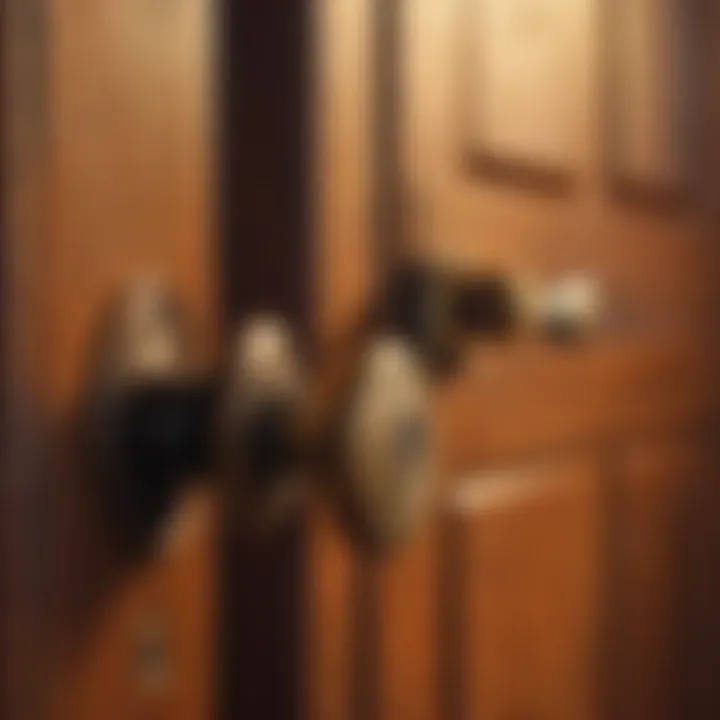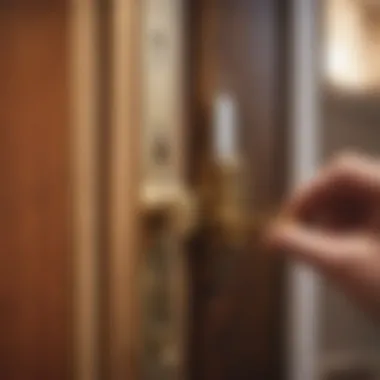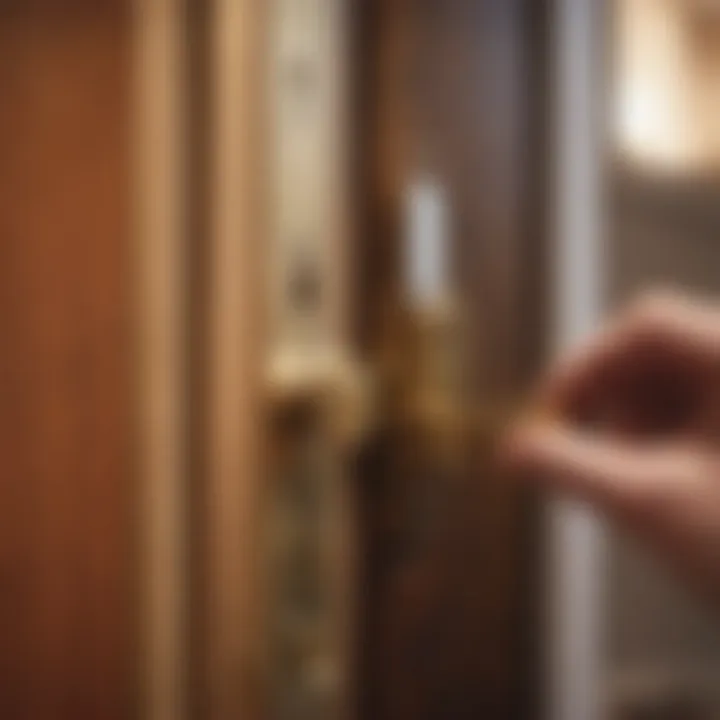Expert Guide on How to Fix a Bedroom Door Lock: Step-by-Step Instructions


Materials:
- Screwdriver (Phillips and flathead)
- Replacement door lock set
- Measuring tape
- Pencil
- Sandpaper
- Safety goggles
- Gloves
DIY Steps:
- Identify the Issue: Start by checking if the key turns fully in the lock or if there are any loose screws or misalignments.
- Remove the Door Handle: Unscrew the handle and set it aside carefully, making sure not to lose any parts.
- Remove the Old Lock: Use the screwdriver to remove the screws holding the old lock in place. Take out the old lock set.
- Install the New Lock: Position the new lock set in place and secure it with the provided screws. Test the functionality to ensure proper installation.
- Reattach the Door Handle: Carefully reattach the door handle by aligning it properly and tightening the screws.
Technical Aspects:
- Tools: Ensure you have the necessary screwdrivers for the job, along with safety equipment like goggles and gloves for protection.
- Timing: Allocate approximately 1-2 hours for this project, depending on your familiarity with DIY tasks.
- Key Techniques: Make sure to measure and align the new lock set accurately for smooth operation.
DIY Project Process:
- Start with Preparation: Gather all materials and tools before starting the project to avoid interruptions.
- Follow the Steps: Proceed as indicated in the DIY Steps section, ensuring each step is completed accurately.
- Troubleshooting Tips: If the lock does not function correctly after installation, double-check the alignment and screws for any issues.
Remember, prioritizing precision and safety will ensure the successful completion of this DIY project.
Understanding the Problem
In this Ultimate Guide on how to fix a bedroom door lock, the section 'Understanding the Problem' plays a vital role as it sets the foundation for successfully addressing door lock issues. By comprehensively grasping the nature of the problem, individuals can effectively troubleshoot and implement the necessary repairs to ensure optimal security and functionality within their homes. Understanding the specific elements of the problem, such as non-turning keys or malfunctioning locks, enables homeowners to approach solutions with precision and efficiency, ultimately safeguarding their living spaces.
Assessing the Situation
Inspecting the Door Lock
When delving into inspecting the door lock as part of the assessment process, individuals gain valuable insights into the root cause of lock-related issues. By carefully examining the lock mechanism for signs of wear, rust, or misalignment, homeowners can pinpoint potential areas of concern. The thorough inspection of the door lock's components allows for a detailed diagnosis, essential for formulating an effective repair strategy. The meticulous scrutiny of the door lock ensures that no underlying issues go unnoticed, promoting a comprehensive approach to addressing lock malfunctions.
Checking for Physical Damage
Checking for physical damage is a fundamental aspect of assessing the door lock's condition. By visually inspecting the lock for visible damages such as dents, scratches, or bent components, individuals can evaluate the severity of the problem. Identifying physical damage is crucial in determining whether repairs or replacements are necessary to restore the lock's functionality. This detailed examination ensures that all potential sources of malfunction are considered, contributing to a thorough assessment of the lock's overall state.
Testing the Key
Testing the key serves as a practical method to ascertain whether the issue lies with the lock or the key itself. By testing the key in different positions and angles within the lock, individuals can determine if irregular key behavior is causing the problem. This step is essential in verifying key functionality and detecting any inconsistencies that may impede proper lock operation. Through systematic testing, individuals can narrow down the factors contributing to the lock issue, paving the way for targeted solutions.
Identifying the Type of Lock


Deadbolt Lock
The deadbolt lock is a foundational component in securing residential doorways, known for its robust construction and reliable security features. With its sturdy bolt that extends into the doorframe, the deadbolt lock provides enhanced resistance against forced entry, making it a popular choice for homeowners seeking heightened protection. Its unique feature of requiring a separate key for locking and unlocking offers added security benefits, ensuring peace of mind for residents. However, the deadbolt lock's installation complexity and potential susceptibility to freezing in extreme temperatures are factors to consider.
Knob Lock
A knob lock serves as a versatile and user-friendly option for securing bedroom doors, characterized by its ease of use and simplistic design. The knob lock's key characteristic lies in its integrated knob and lock mechanism, granting convenient access while maintaining adequate security levels. Its smooth operation and compatibility with various door materials make it a practical choice for residential settings. However, knob locks may pose a higher risk of manipulation by intruders due to their exposed key slot, necessitating extra vigilance from homeowners.
Latch Lock
The latch lock offers a cost-effective solution for basic door security, featuring a latch mechanism that holds the door in a closed position. Its key characteristic of easy installation and minimal maintenance requirements make it a popular choice for homeowners seeking uncomplicated security solutions. The latch lock's unique feature lies in its versatile design, compatible with different door types and styles. While latch locks provide basic security functions, they may lack the robustness and intrusion resistance of deadbolt locks, requiring homeowners to balance cost considerations with security needs.
Common Issues and Solutions
Key Doesn't Turn
When faced with the issue of a key not turning in the bedroom door lock, lubricating the lock is often a necessary step in the repair process. Applying lubricant to the keyway can help alleviate friction and ensure smooth operation. This method is popular due to its simplicity and effectiveness in enhancing the lock's functionality. While lubricating the lock can offer temporary relief, it's important to note that over-reliance on this method may lead to debris buildup and cause further issues.
Adjusting the strike plate is another critical aspect to consider when troubleshooting a key that doesn't turn. Ensuring the strike plate aligns correctly with the latch can help resolve issues related to misalignment. This adjustment is beneficial as it optimizes the door's locking mechanism, promoting secure closure. However, improper adjustment may result in continued difficulty turning the key or potential damage to the door frame.
Replacing the key altogether may be necessary if the existing key is worn out or damaged beyond repair. This solution provides a long-term fix to the key turning issue, ensuring reliable access to the bedroom. While replacing the key offers a definitive solution, it is important to have a duplicate key available to prevent future lockouts.
Door Won't Lock
Facing a door that won't lock can be a significant security concern for homeowners. Tightening loose screws within the lock mechanism can often resolve this issue. By ensuring all screws are secure, the locking mechanism regains stability, allowing for proper function. This solution is advantageous as it prevents unauthorized entry and safeguards the property.
Aligning the door properly is another key step in addressing a door that won't lock. Correct alignment of the door within the frame promotes smooth operation of the locking mechanism, preventing jams or misalignment issues. Proper door alignment enhances overall security measures, providing peace of mind for homeowners. However, improper alignment may lead to ongoing difficulties in securing the door.
In some cases, replacing the lock mechanism becomes necessary to restore the door's ability to lock securely. This solution involves installing a new lock mechanism that is compatible with the door, ensuring optimal functionality and security. Installing a new lock mechanism offers a fresh start in securing the bedroom, but it's essential to choose a high-quality replacement to guarantee lasting performance.
Tools Needed for Repair
When it comes to fixing a bedroom door lock, having the right tools is crucial for a successful repair job. This section outlines the essential tools that are necessary for this task, highlighting key elements that ensure a smooth repair process.
Essential Tools
Screwdriver


A screwdriver is a fundamental tool in any repair kit and plays a vital role in fixing a door lock. Its versatility in removing and securing screws makes it indispensable for accessing the inner mechanisms of the lock. The key characteristic of a screwdriver lies in its ability to apply torque to screws, allowing for easy disassembly and reassembly of lock components. In this article, the screwdriver's ergonomic grip and various tip options make it a popular choice for addressing lock issues. Its unique feature of adjustable tips caters to different screw types, providing the necessary flexibility for tackling various lock structures.
Tape Measure
The tape measure serves a crucial purpose in ensuring precise measurements during the repair process. Accurate measurements are essential for determining the correct sizing of replacement parts or assessing the alignment of the door and lock mechanism. The key characteristic of a tape measure is its retractable tape, which enables users to measure distances with accuracy and ease. In this article, the tape measure's durability and ease of use make it a beneficial tool for obtaining measurements crucial to fixing a door lock. Its unique feature of extended stand-out distance enhances usability, especially in hard-to-reach areas.
Replacement Lock Parts
Having replacement lock parts on hand is essential for addressing specific issues within a door lock. These parts, such as latch assemblies or tumblers, contribute significantly to restoring a lock's functionality. The key characteristic of replacement lock parts is their compatibility with a wide range of lock types and brands, ensuring versatility in repair scenarios. In this article, the availability of various lock part options and ease of installation make them a popular choice for resolving lock-related issues. Their unique feature of being manufactured from durable materials ensures long-term performance, despite frequent use.
Optional Tools
Pliers
Pliers are versatile tools that offer a firm grip, making them indispensable in handling small components during repair tasks. Their key characteristic lies in their ability to provide controlled leverage when maneuvering small screws or parts. In this article, the precision and strength of pliers make them a beneficial choice for intricate lock repairs. The unique feature of needle-nose pliers allows for accessing tight spaces, enhancing the tool's functionality. While their advantages include precise handling, some disadvantages may arise from limited grip strength when dealing with larger components.
Hammer
A hammer is a basic yet impactful tool that aids in gentle adjustments or forceful taps during the repair process. Its key characteristic is the striking head, which delivers controlled impact for tasks such as aligning door components. In this article, the hammer's versatility in handling different materials and providing adjustable force makes it a practical choice for door lock repairs. The unique feature of a rubberized grip minimizes slippage and enhances safety during use. While its advantage lies in its versatility, the disadvantage may include potential damage to delicate components if excessive force is applied.
Drill
A drill is a power tool that offers precision drilling and screwdriving capabilities essential for certain repair tasks. Its key characteristic is the variable speed settings, allowing users to control drilling depth and speed based on the material being worked on. In this article, the drill's efficiency in drilling pilot holes or assembling lock components makes it a valuable tool for advanced repair scenarios. The unique feature of interchangeable bits provides versatility in handling different screw types, enhancing the drill's usability. While its advantage includes rapid drilling, potential disadvantages may arise from battery dependence or excessive noise during operation.
Step-by-Step Repair Guide
In this article, the 'Step-by-Step Repair Guide' section plays a crucial role in equipping readers with a detailed roadmap to effectively fix a bedroom door lock. By breaking down the repair process into manageable steps, this guide simplifies what can seem like a daunting task. The step-by-step approach ensures that readers can address each aspect of the repair methodically, leading to a more successful outcome. Not only does this section provide a clear structure, but it also instills confidence in individuals tackling the repair for the first time.
Preparing for Repair
Gathering Necessary Tools
Gathering necessary tools is a pivotal step in the door lock repair process. Having the right tools at hand streamlines the repair procedure and reduces the chance of interruptions or delays. In this article, the emphasis on specific tools such as a screwdriver, tape measure, and replacement lock parts underscores their indispensable role. These tools are carefully chosen for their precision and utility, ensuring that readers can execute the repair with accuracy and efficiency. Their high-quality construction and compatibility with door lock systems make them ideal choices for this article, setting readers up for a successful repair experience.
Securing the Door
Securing the door is a critical aspect of the repair process, as it provides a stable foundation for carrying out subsequent tasks. The key characteristic of securing the door lies in its ability to create a safe working environment by immobilizing the door and preventing unintentional movements. In this article, the unique feature of securing the door through specific methods is highlighted for its advantages in enhancing repair precision and safety. While securing the door may require some time and effort, its benefits in terms of facilitating a smooth repair process far outweigh any minor inconveniences.


Troubleshooting and Fixing
Removing the Door Handle
Removing the door handle is a fundamental step in troubleshooting and fixing a problematic bedroom door lock. The extraction of the door handle allows access to internal components, enabling a thorough assessment of the lock mechanism. This article stresses the importance of this procedure for its specific contribution to identifying underlying issues and implementing effective solutions. The unique feature of smoothly removing the door handle ensures minimal further damage to the lock assembly, a critical factor in optimizing repair outcomes.
Inspecting the Lock Cylinder
Inspecting the lock cylinder is a key element in diagnosing door lock malfunctions and determining the root cause of operational issues. By focusing on this specific aspect, readers can gain insights into potential mechanical problems or wear and tear affecting the lock's functionality. This section of the article highlights the significance of a detailed inspection for its role in guiding targeted repair efforts and ensuring long-term door lock performance. The unique feature of thorough examination enhances the accuracy of troubleshooting, leading to more precise repair solutions.
Replacing the Lock Assembly
Replacing the lock assembly is a comprehensive solution to persistent door lock issues that cannot be resolved through minor adjustments. This segment of the article emphasizes the significance of this task for its ability to address serious lock malfunctions effectively. The key characteristic of lock assembly replacement lies in its capacity to restore full functionality to the door lock, ensuring optimal security and peace of mind. By outlining the specific steps involved in this process, readers are guided through a meticulous approach that guarantees successful replacement with minimal complications.
Final Checks and Maintenance
In this comprehensive guide on fixing a bedroom door lock, the Final Checks and Maintenance section plays a crucial role in ensuring the effectiveness and longevity of the repair process. By focusing on final checks, individuals can verify that the repair has been accurately executed and that the lock is operating correctly.
Testing the repair is a critical step to ascertain the success of the fixing process. By checking the key operation, individuals can guarantee that the lock responds appropriately to the key, ensuring seamless functionality. Furthermore, testing the lock's functionality provides assurance that the locking mechanism operates smoothly, offering peace of mind regarding the security of the bedroom.
Testing the Repair
Checking Key Operation
Checking key operation involves testing the key within the lock to verify its smooth insertion and turning. This ensures that the key aligns correctly with the lock mechanism, allowing for easy unlocking and locking of the door. The key characteristic of checking key operation lies in its ability to pinpoint any potential issues with key alignment or the lock cylinder, facilitating immediate rectification and enhancing overall security. This approach is highly beneficial for this article as it emphasizes the importance of attention to detail in door lock maintenance.
Testing Lock Functionality
Testing lock functionality involves verifying that the lock smoothly engages and disengages without any hitches. This key characteristic ensures that the lock operates seamlessly, providing the desired security features effectively. The unique feature of testing lock functionality lies in its ability to assess the lock's performance under practical conditions, offering insights into any potential operational challenges. While the advantages of this method include ensuring a properly functioning lock system, one must be cautious of any anomalies that might indicate the need for further inspection or potential repairs.
Routine Maintenance Tips
In the context of fixing a bedroom door lock, routine maintenance holds paramount importance in ensuring the longevity and optimal performance of the lock system. Regular lubrication stands out as a critical aspect of maintenance, as it helps reduce friction within the lock mechanism, promoting smooth operation. Periodic inspections enable homeowners to proactively identify any emerging issues, preventing potential lock failures and security breaches. Engaging in professional servicing periodically ensures that any complex problems are addressed by experts, maintaining the security and functionality of the door lock system.
Regular Lubrication
Regular lubrication involves applying lubricant to the lock mechanism to reduce friction and promote smooth operation. This key characteristic benefits the article by emphasizing the importance of consistent maintenance to prevent lock malfunctions and prolong the lock's lifespan. The unique feature of regular lubrication lies in its ability to enhance the overall functionality of the lock, providing ease of use for homeowners. While advantageous in optimizing lock performance, individuals should be mindful of using the appropriate lubricant to prevent damage to the lock components.
Periodic Inspections
Periodic inspections play a vital role in detecting early signs of wear and tear in the lock mechanism, allowing for timely intervention and maintenance. The key characteristic of periodic inspections lies in their preventive nature, minimizing the risk of unexpected lock failures. This approach is advantageous for this article as it underscores the importance of proactive maintenance to ensure the security of the bedroom door. While conducting periodic inspections, individuals can identify potential issues before they escalate, safeguarding against lock-related emergencies and ensuring peace of mind.
Professional Servicing
Professional servicing encompasses seeking expert assistance for intricate lock issues that may require specialized knowledge and tools. The key characteristic of professional servicing lies in its comprehensive approach to diagnosing and resolving complex lock problems effectively. This choice is beneficial for this article as it highlights the significance of expert intervention in maintaining the security and functionality of the bedroom door lock. The unique feature of professional servicing is the assurance of quality repairs by skilled professionals, ensuring optimal performance and security. While advantageous in addressing challenging lock issues, individuals should consider professional servicing as a viable solution for intricate repairs beyond DIY capabilities.







